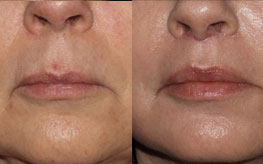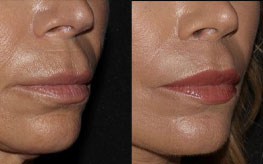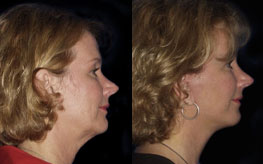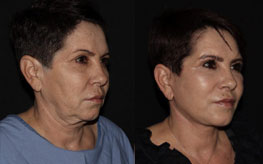Thigh Lift
Conveniently located to serve the areas of San Diego, CA

A thigh lift is a surgical procedure during which a surgeon removes redundant skin from the thighs. Fluctuations in weight, growing older, and genetics can cause the legs to take on a drooping, sagging appearance. (1) Exercise may strengthen and improve the underlying muscle tone of the thighs and hips, but it cannot address excess skin that has lost elasticity or underlying weakened tissues and localized fat deposits.
If fitness and weight loss efforts have not helped you reach your goals for a lower body that is firmer, more youthful-looking, and more proportionate to your overall body image, a thigh lift may be right for you. This surgery contours the thighs by removing excess skin and fat, resulting in smoother skin and more balanced lower body contours.
At Alexander Cosmetic Surgery in San Diego, Dr. John Alexander incorporates the latest techniques into his work at his practice. By performing a thigh lift, we can help you achieve a natural-looking, elegant body contour.
For more information about our thigh lift procedure or to schedule a consultation, please contact us online or call us at (858) 455-7557. We look forward to helping you look your best!
Contents
About Thigh Lifts
The thighs are often one of the first parts of the body to show signs of aging or weight fluctuations. They are made up of layers of muscle, fat, and skin, requiring careful consideration when undergoing any body contouring procedures. An imbalance in skin elasticity, excessive fat, or genetics can contribute significantly to dissatisfaction with this area.
A thigh lift can address these issues. With it, you will be able to:
- Reduce excess skin and fat on the thigh
- Reshape your thighs to result in smoother skin and contours
- Create a more toned and proportionate appearance
There are several types of thigh lift procedures:
- Medial thigh lift: This kind of thigh lift removes excess skin and fat from the upper, and inner leg, placing the incision in the groin and buttocks crease. (1)
- Lateral thigh lift: The lateral thigh lift removes skin from the sides of the legs and requires an incision on the outer aspect of the upper thigh. (1)
- Circumferential thigh lift: This lift is a combination of a medial and a lateral thigh lift done together. (1)
- Longitudinal thigh lift: Your surgeon can remove skin from inside the thigh running from the groin down to the knee. (2) This incision is much longer and is similar to that of an arm lift. The advantage is that much more skin can be removed by this technique. This procedure is usually done on individuals who have lost significant weight, either on their own, after gastric bypass surgery, or after using GLP-1 medications.
Thigh lifts are intended for the removal of excess skin, not excess fat. Liposuction can remove excess fat deposits where the skin has good elasticity and can naturally conform to new body contours. (1,2) In cases where skin elasticity is poor, your surgeon might recommend a combination of liposuction and thigh lift techniques.
Benefits
Undergoing a thigh lift procedure offers numerous advantages that contribute to enhanced aesthetics and improved self-esteem:
- Improved Contour: The primary benefit of a thigh lift is the significant enhancement of your thigh contours, leaving you with a more toned appearance.
- Elimination of Excess Skin: The procedure effectively removes sagging skin that often develops after weight fluctuation or aging.
- Minimized Chafing: Reducing excess skin can decrease friction between the thighs, which is especially beneficial for physically active individuals.
- Youthful Appearance: A thigh lift restores a youthful shape, making your legs appear slimmer and firmer.
- Enhanced Body Proportions: By achieving balance among different body areas, your overall silhouette can appear more harmonious.
- Increased Confidence: Many individuals experience boosted self-esteem after the procedure, feeling more comfortable in their clothing and swimwear.
- Long-Lasting Results: With proper maintenance—including a healthy lifestyle—results can last for many years.
Candidates
In general, candidates for a thigh lift include:
- Those with significant thigh skin laxity
- Individuals who have lost significant weight
- Those with stable weight and are not significantly overweight
- Healthy individuals who do not have medical conditions that can impair healing or increase risks
- Non-smokers
- Individuals with a positive outlook and realistic expectations
Personal Consultation
The success and safety of your thigh lift depend very much on your being completely candid during your personal consultation. We will ask you questions about your health, desires, and lifestyle.
Be prepared to discuss:
- Why you want a thigh lift, your expectations and desired outcomes
- Medical conditions, drug allergies, and medical treatments
- Use of current medications, vitamins, herbal supplements, alcohol, tobacco and drugs,
- Previous surgeries
During a personal consultation, we may also:
- Evaluate your general health status and any pre-existing health conditions or risk factors
- Examine your legs, and take note of your skin quality
- Take photographs for your medical record or for computer imaging
- Discuss your options and recommend a course of treatment
- Discuss likely outcomes of a thigh lift and any risks or potential complications
- Discuss the use of anesthesia during your procedure
To ensure the most natural-looking results, Dr. Alexander will recommend the thigh lift procedure that most appropriately matches your needs. Because a thigh lift requires long incisions, your surgeon may discourage you from having the procedure if your skin laxity does not seem excessive enough to warrant the resulting scar.
To schedule this personal consultation, please contact us online or call us at (858) 455-7557.
Preparation
During a preoperative appointment, usually 1-2 weeks before surgery, we will request lab testing or a medical evaluation. We will explain post-operative care and follow-up, and what help you will need after the procedure. These instructions typically include the following guidelines:
- Take certain medications or adjust your current medications
- Avoid taking aspirin, anti-inflammatory drugs, and herbal supplements as they can increase bleeding
- Stop smoking well in advance of surgery
Procedure
An anesthesiologist will administer general anesthesia, which is recommended for this procedure. However, smaller lifts can be done with IV sedation. The technique your surgeon uses for your procedure will depend on your thigh size and shape, your skin quality and elasticity, and the degree of skin sagging. The procedure typically takes 2.5-4 hours depending on the individual and certain surgical variables. There are four basic steps to a thigh lift: marking, making incisions, removing excess tissue, and closing the incisions.
Step 1 – Marking
While you are in a standing position, your surgeon will make careful measurements and markings on the thighs. This is an important part of the procedure, and it requires skill, patience, experience, and a good eye for symmetry and detail to place the incisions precisely.
Step 2 – The Incisions
Incision length and pattern depend on the amount and location of excess skin your surgeon will remove.
- Medial thigh lift: These incisions are usually along the groin crease and extend posteriorly into the buttock crease.
- Lateral thigh lift: Incisions extend from the groin, around the outside of the thigh, to the buttock crease.
- Circumferential thigh lift: The incision runs all the way around the upper thigh, with the middle portion hidden in the groin and buttocks crease. The lateral aspect of the incision is visible on the upper outer thigh, and can usually be hidden under a swimsuit or underwear.
- Longitudinal thigh lift: The incision runs vertically from the groin to the knee, on the medial region of the thigh.
Step 3 – Removing Excess Tissue
Your surgeon removes excess fat and skin all the way down to the muscle. Then, he will tighten underlying supportive tissue and reshape it with internal sutures. If there is a small amount of fat to be reduced during your thigh lift, he can either excise it directly with the skin or remove it with liposuction. Depending on your specific conditions, incisions may be more limited.
Step 4 – Closing the incisions
Your surgeon smooths the skin over the new leg contours. He will close your incisions with absorbable sutures and nonabsorbable sutures. He will remove the nonabsorbable sutures within 3-5 days following your thigh lift. Incision lines are permanent, but in most cases, scars will fade and significantly improve over time.
Recovery
We will provide you with compression garments after your surgery, which you will have to wear for several weeks to minimize swelling and support the tissues as they heal. The smoother, tighter contouring results from a thigh lift are apparent almost immediately, although some swelling and bruising may obscure the results at first. Following a thigh lift, skin quality is dramatically improved both in appearance and feel.
Results

Incision lines are permanent but will continue to fade over time. If you avoided wearing shorts prior to surgery, you may feel more comfortable wearing such clothing after the procedure. Like most patients who have had a thigh lift, you may also have a boost in self-confidence.
Over time, your legs can continue to change due to aging and gravity. However, you will be able to retain your new look longer if you maintain your weight and keep a healthy lifestyle. As your body ages, it is natural to lose some firmness, but a lot of improvements can be long-lasting. In some situations, it may not be possible to achieve optimal results with a single surgical procedure, and another surgery may be necessary.
Cost of a Thigh Lift in San Diego
We will provide you with a quote for your thigh lift after your initial consultation. For more information about thigh lift procedures at Alexander Cosmetic Surgery, please contact us online or call us at (858) 455-7557.
FAQ
How long does recovery take after a thigh lift?
Recovery times vary, but many patients can usually expect to be able to return to light activities within 2 to 3 weeks. Full results may take several months to fully manifest.
Can I combine other procedures with a thigh lift?
Yes, many patients choose to combine a thigh lift with other body contouring surgeries, such as abdominoplasty (tummy tuck) or liposuction, as these can help the individual achieve more overall body enhancement.
Are scars visible after a thigh lift?
While scars are inevitable after a surgical thigh lift, your surgeon will place incisions strategically to keep them as inconspicuous as possible. Over time, these scars can fade significantly.
Will a thigh lift help me lose weight?
While a thigh lift improves the appearance of your thighs, it is not intended as a weight-loss method. Maintaining a stable weight post-surgery will enhance long-term results.
References
- Bell D, Winters R. Thighplasty. PubMed. Published 2023. https://www.ncbi.nlm.nih.gov/books/NBK594236/
- Hurwitz DJ. Thighplasty in the Weight Loss Patient. Seminars in Plastic Surgery. 2006;20(01):038-048. doi:https://doi.org/10.1055/s-2006-932448





